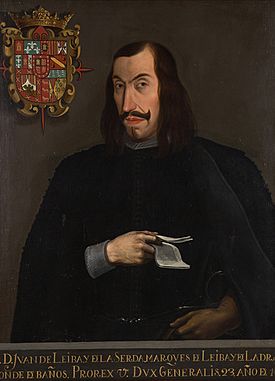Juan Francisco Leiva y de la Cerda facts for kids
Quick facts for kids
Juan Francisco de Leiva y de la Cerda
Marquess of Adrada, Count of Baños
|
|
|---|---|
 |
|
| 23rd Viceroy of New Spain | |
| In office 16 September 1660 – 29 June 1664 |
|
| Monarch | Philip IV |
| Preceded by | Francisco Fernández de la Cueva y Enriquez de Cabrera |
| Succeeded by | Diego Osorio de Escobar y Llamas |
| Personal details | |
| Born | 2 February 1604 Alcalá de Henares, Spain |
| Died | 27 March 1678 (aged 74) Guadalajara, Spain |
Juan Francisco de Leyva y de la Cerda was a Spanish nobleman. He was also known as the 5th Marquess of Adrada and the 2nd Count of Baños. He lived from 1604 to 1678. From 1660 to 1664, he served as the viceroy of New Spain. This was a very important job in the Spanish colonies.
Contents
Becoming Viceroy of New Spain
Juan Francisco de Leyva y de la Cerda came from an old and important Spanish noble family. From a young age, he joined the navy. He served alongside his grandfather, Pedro de Leyva y Mendoza. His grandfather was a captain general of Spanish galleys.
He fought against pirates from Algeria. Later, in 1626, he helped fight against Catalan rebels in Tarragona, Spain.
King Philip IV chose him to be the viceroy of New Spain. This happened on February 26, 1660. He was 56 years old at the time. He arrived in the capital city of the viceroyalty on September 16, 1660. His family came with him.
Challenges During His Time as Viceroy
Juan Francisco de Leyva y de la Cerda and his family were known for being arrogant and rude. People also thought they were very greedy. Because of this, his time as viceroy was not very successful.
Soon after he arrived, his son Pedro had a serious incident with a servant. This led to a lot of anger from the conde de Santiago. Pedro de Leyva then tried to hire people to harm the conde. This plan did not work. As a result, many important families in the viceroyalty started to dislike the viceroy and his family. Many complaints and accusations were sent to the king in Madrid.
The actions of the viceroy's helpers caused problems. Several groups of Native Americans rebelled. The most well-known rebellion happened in 1661. The Native Americans of Tehuantepec rose up. They were led by their mayor, Juan Arellano. The bishop of Oaxaca, Alonso Cuevas Dávalos, helped calm things down. He used his influence to make peace.
In 1662, the viceroy made a controversial order. He wanted a religious parade, called Corpus, to change its route. He wanted it to pass in front of his palace. This way, his wife could watch it from her balcony. The church leaders strongly protested this decision. The king's court not only disagreed with the viceroy. They also fined him a large amount of money.
The viceroy also took lands and properties. He gave them to his family and friends. He also used them to pay back a large loan. This loan was for 200,000 pesos from New Spain's treasury to the Spanish Crown. In 1662, he took over lands near his country home. He wanted his staff to live there when he visited. Also in 1662, he took control of goods arriving in Veracruz from Europe. He made merchants in Mexico City pay money right away. This money was then sent to Spain.
Returning to Spain
The complaints against the viceroy became too much for the king. The Crown removed him from his position. They appointed Diego Osorio de Escobar y Llamas as the temporary viceroy. He was the bishop of Puebla. However, de Leyva de la Cerda tried to hide the king's orders. He continued to govern. He only stopped when the bishop arrived in the capital. The bishop then publicly showed his authority.
De Leyva's departure from the capital was not pleasant. People booed him and threw stones. But many people were also very relieved to see him go.
Leyva sailed back to Spain on September 15, 1664. When he met the king, he was strongly criticized. The king banned him from serving the Court ever again. After his wife passed away, he became very sad. He then joined a Carmelite monastery in Madrid. There, he took the name Fray Juan de San José. He performed his first mass on October 27, 1676. He later moved to the monastery of San Pedro in Guadalajara. He died there in 1678.
See also
 In Spanish: Juan Francisco de Leyva y de la Cerda para niños
In Spanish: Juan Francisco de Leyva y de la Cerda para niños

